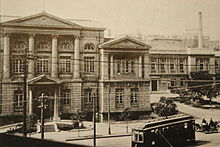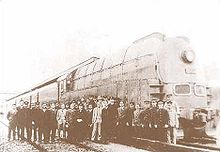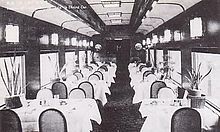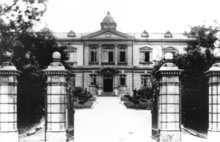- South Manchuria Railway
-
The South Manchuria Railway Company (南満州鉄道株式会社/南満洲鉄道株式会社 Minami Manshū Tetsudō Kabushiki-gaisha, or 満鉄 Mantetsu)(Chinese: 南满铁路) was a company founded in the Empire of Japan in 1906, after the Russo-Japanese War (1904-1905), and operated within China in the Japanese-controlled South Manchuria Railway Zone. The railway itself ran from Lüshun Port at the southern tip of the Liaodong Peninsula to Harbin, where it connected to the Chinese Eastern Railway.
Contents
History
Following the Japanese victory over Imperial Russia and the signing of the Treaty of Portsmouth, the southernmost section of the southern branch (Harbin - Port Arthur) of the China Far East Railway was transferred to Japanese control. The last station remaining in Russian hands was Kuancheng (Kuanchengtze, in contemporary spelling); the first Japanese station was Changchun.[1] [2]
A new, semi-privately-held company was established with a capitalization of 200 million yen to operate the railroad and to develop settlements and industries along its route.[3] The organizing committee was headed by General Kodama Gentarō, and after his death, by General Terauchi Masatake. Count Gotō Shimpei, formerly Japanese governor of Taiwan, was appointed the first president, and the headquarters of the company was established in Dairen.[4]
One of the first tasks of the new company was to change the railway gauge. Although the rail line was originally built on the Russian gauge (5 ft), during the war it had been converted by the advancing Japanese troops to the Japanese 3 ft. 6 in. gauge, in order to facilitate the use of rolling stock brought from Japan. But once the new Japanese South Manchuria Railway company took possession of the line, it had it re-gauged again, now to the standard gauge (4 ft. 8.5 in.).[5] In 1907, an agreement was reached between the Japanese and Russian authorities about connecting the Japanese South Manchuria Railway with the line to the north, remaining in the hands of Russian China Far East Railway. According to the agreement, Russian gauge tracks would continue from the "Russian" Kuancheng Station to the "Japanese" Changchun Station, and vice versa, tracks on the "gauge adapted by the South Manchuria Railway" (i.e., the standard gauge) would continue from the Changchun Station to the Kuancheng Station.[2]
By the end of 1907, the company employed 9,000 Japanese and 4,000 Chinese. By 1910, those numbers had increased to 35,000 and 25,000 respectively.[4] The railway used a significant amount of US-made rails and signaling equipment, as well as some steam locomotives built by the American Locomotive Company at Dunkirk, NY. A visiting executive from the Erie Railroad was quite impressed with the arrangement, and described South Manchurian Railway ca. 1913 as "the only railroad in the whole world that is like our American railroads (and they are, fairly speaking, the best)".[5]
Mantetsu quickly expanded the system inherited from Russia to staggering proportions, building coal mines at Fushun and Yantai, and harbor facilities at Andong, Yingkou, and Dalian. At each station, Mantetsu built hotels for travelers and warehouses for goods. Japanese settlers were encouraged through the construction of schools, libraries, hospitals and public utilities. The Mantetsu Research Wing was the centerpiece of Japan's colonial program, and instigated agricultural research into development of soybean farming. Land under cultivation expanded 70% in 20 years.[6]
From 1916, Mantestu began to spin off a number of subsidiary companies, including Showa Steel Works, Dalian Ceramics, Dalian Oil & Fat, South Manchurian Glass, as well as flour mills, sugar mills, electrical power plants, shale oil plants and chemical plants.[7]
Until 1925, the company also operated the Korean railway system.
Company assets rose from 163 million yen in 1908 to over a billion yen in 1930. Mantetsu was by far the largest corporation in Japan, and also its most profitable, averaging rates of return from 25-45 percent per year.[6] During the 1920s, Mantetsu provided for over a quarter of the Japanese government's tax revenues.[8]
Over 75% of Mantetsu's income was generated by its freight business, with the key to profitability coming from soybean exports, both to Japan proper and to Europe. Soybean production increased exponentially with increasing demand for soy oil, and for soy meal for use in fertilizer and animal feed. By 1927, half of the world's supply of soybean was from Manchuria and the efforts by Mantetsu to expand production and to ship to export ports was a classic example of an extractive colonial economy dependent on a single product.[8]
The South Manchuria Railway was also charged with a government-like role in managing the rail transportation system after the formation of Manchukuo in 1932. By 1938, Mantetsu had 72 subsidiary companies, development projects in 25 urban areas and carried 17,515,000 passengers per year.[9] Between 1930-1940, the Japanese population of Manchukuo rose by 800,000 making ethnic Japanese the majority in many of the towns and cities served by Mantetsu. Mantetsu prided itself on state-of-the-art urban planning, with modern sewer systems, public parks, and creative modern architecture far in advance of what could be found in Japan itself. These things possible due to Mantetsu's tremendous profitability, and its political power to seize property and silence opposition and dissent at will through its political connections to the military and totalitarian national leadership.[10]
In 1934, Mantetsu inaugurated the "Asia Express", a high speed train from Dalian to the Manchukuo capital of Hsinking. Reaching a top speed of 134 km/h (83 mph), the "Asia Express" was the fastest scheduled train in Asia at the time.
Changchun remained the break of gauge point between the Russian and standard gauges into the 1930s,[11] until the Chinese Eastern Railway itself was bought by Manchukuo and converted to the standard gauge in the mid-1930s.
In 1945, the Soviet Union invaded and overran Manchukuo. Rolling stock and moveable equipment was looted, and taken back to the Soviet Union, some of which was returned when the Chinese Communist government came into power. Mantetsu itself was dissolved by order of the American occupation authorities in occupied Japan.
Presidents
Name From To 1 Shinpei Goto 13 November 1906 14 July 1908 2 Yoshikoto Nakamura 19 December 1908 18 December 1913 3 Ryutaro Nomura 19 December 1913 15 July 1914 4 Yujiro Nakamura 15 July 1914 31 July 1917 5 Shimbei Kunisawa 31 July 1917 12 April 1919 6 Ryutaro Nomura 12 April 1919 31 May 1921 7 Senkichiro Hayakawa 31 May 1921 14 October 1922 8 Takeji Kawamura 24 October 1922 22 June 1924 9 Banichiro Yasuhiro 22 June 1924 19 July 1927 10 Jōtaro Yamamoto 19 July 1927 14 August 1929 11 Mitsugu Sengoku 14 August 1928 13 June 1931 12 Yasuya Uchida 13 June 1931 6 July 1932 13 Hakutaro Hayashi 26 July 1932 2 August 1935 14 Yōsuke Matsuoka 2 August 1935 24 March 1939 15 Takuichi Ohmura 24 March 1939 14 July 1943 16 Naoto Kohiyama 14 July 1943 11 April 1945 17 Motoki Yamazaki 5 May 1945 30 September 1945 See also
- Kwantung Leased Territory
- South Manchuria Railway Zone
- Yamato Hotels
References
- ^ Changchun Ⅱ- Le chemin de fer de Changchun (French)
- ^ a b "Provisional Convention ... concerning the junction of the Japanese and Russian Railways in Manchuria" - June 13, 1907. Endowment for International Peace (2009). Manchuria: Treaties and Agreements. BiblioBazaar, LLC. p. 108. ISBN 1113111674. http://books.google.com.au/books?id=Lb-FhmJ-DXcC.
- ^ Young, Japan's Total Empire, pp 25
- ^ a b Coox, Nomonhan pp.6
- ^ a b Luis Jackson, Industrial Commissioner of the Erie Railroad. "Rambles in Japan and China". In Railway and Locomotive Engineering, vol. 26 (March 1913), pp. 91-92
- ^ a b Coox, Nomonhan pp.21
- ^ Young, Japan’s Total Empire, pp32
- ^ a b Young, Japan's Total Empire, pp 31-32
- ^ Coox, Nomonhan, pp 1078
- ^ Young, Japan’s Total Empire, pp.250
- ^ Yesterday and To-day, The New Zealand Railways Magazine, Volume 6, Issue 8 (April 1, 1932.)
- Coox, Alvin (1990). Nomonhan: Japan Against Russia, 1939. Stanford University Press. ISBN 0804718350.
- Young, Louise (1999). Japan's Total Empire: Manchuria and the Culture of Wartime Imperialism. University of California Press. ISBN 0520219341.
External links
Empire of Japan General topics Agriculture • Censorship • Demographics • Economic and financial data • Economic history • Education • Eugenics • Foreign commerce and shipping • Industrial production • Militarism • Nationalism • Statism • Internal politics

Emperors Government Constitution • Charter Oath • House of Representatives • House of Peers • Daijō-kan • Ministry of Taxation • Ministry of the Treasury • Ministry of Foreign Affairs (Japan) • Ministry of Commerce • Ministry of Agriculture and Forestry • East Asia Development Board (Kōain) • Foreign relations • Government and military commanders of World War II • Gozen Kaigi • Ministry of Greater East Asia • Home Ministry • Imperial Rescript on Education • Imperial Way Faction (Kōdōha) • Kokutai • National Spiritual Mobilization Movement • Peace Preservation Law • Political parties • State Shinto • Supreme Court of Judicature • Taisei Yokusankai • Tokkō • Tonarigumi • Tōseiha • Tripartite Pact • Greater East Asia ConferenceMilitary Imperial General Headquarters • Imperial Japanese Army • Imperial Japanese Navy • Ministry of the Military • Ministers of Army of Japan • Ministry of the Navy of Japan • Taiwanese Imperial Japan Serviceman • Imperial Guard • Nuclear weapons program • Kamikaze • War crimes • Supreme War Council • Japanese holdoutEmblems History Meiji Restoration • Meiji period • Boshin War • Satsuma Rebellion • First Sino-Japanese War • Triple Intervention • Boxer Rebellion • Anglo-Japanese Alliance • Russo-Japanese War • Taishō period • During World War I • During the Siberian Intervention • General Election Law • Shōwa period • Shōwa financial crisis • Pacification of Manchukuo • Second Sino-Japanese War • Tripartite Pact • Soviet–Japanese Neutrality Pact • Pacific War • Atomic bombings of Hiroshima and Nagasaki • Soviet invasion of Manchuria • Surrender • OccupationExpansionism Greater East Asia Co-Prosperity Sphere • Occupied territories (Hong Kong • Indonesia • Korea • Malaysia • Manchuria • The Philippines • Singapore • Taiwan • Thailand • Vietnam • South Pacific Mandate)Other Fukoku kyōhei • German pre-World War II industrial co-operation • Hakkō ichiu • Racial Equality Proposal • Shinmin no Michi • Shōwa Modan • Socialist thought • Yasukuni Shrine• International Military Tribunal for the Far EastCategories:- History of Manchuria
- Defunct companies of Japan
- Foreign relations of the Empire of Japan
- History of the foreign relations of the Republic of China
- Russian Empire
- Manchukuo
- Rail transport in the People's Republic of China
- Railway companies established in 1906
Wikimedia Foundation. 2010.





